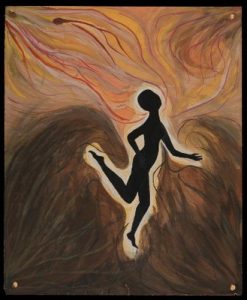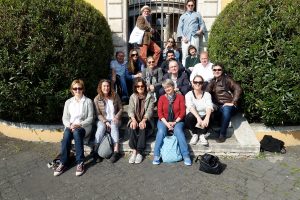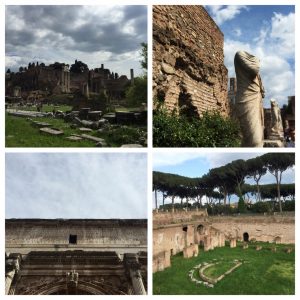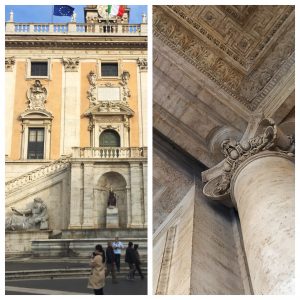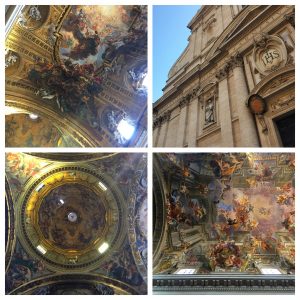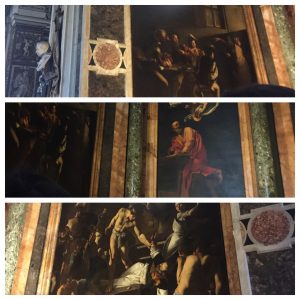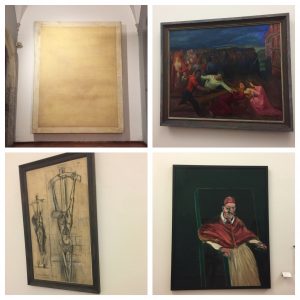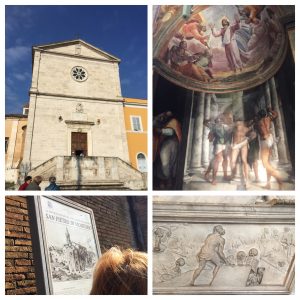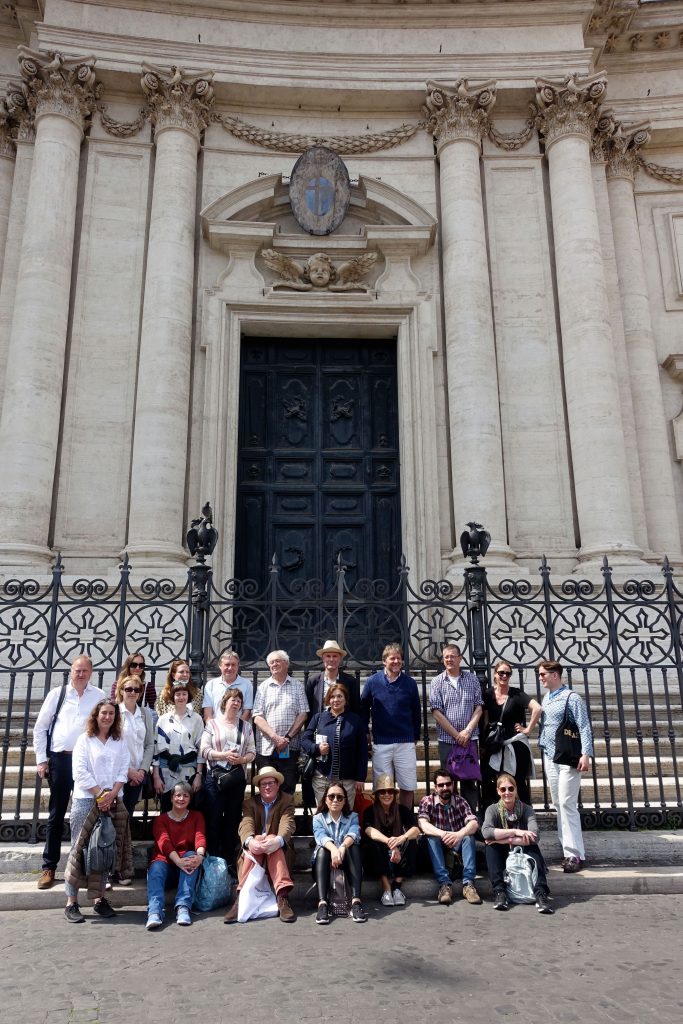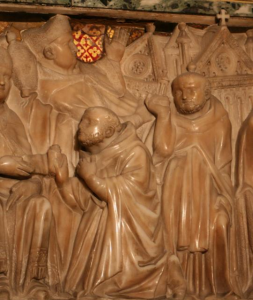I do hope many of you were able to join in Arts Week last week, and come to one of the more than fifty events laid on by colleagues in the School of Arts between Monday 15th and Saturday 19th May. There were lectures, seminars, film screenings, readings, performances, panel discussions and a sound installation – not to forget the fantastic Friday night concert at which we were treated to the musical talents of Dr. Jo Winning from the Department of English and Humanities, and Anthony Shepherd, Programme Administrator for MPhil/PhD Research across the School of Arts. All of our History of Art research students will know Anthony very well indeed – but some of you may not know that he is also one half of the highly successful folk music outfit, Pepper and Shepherd!
More than 1,500 people came to Gordon Square to take part in Arts Week – but, if you missed anything of interest, or want to relive a particular event, then do take a look at the Arts Week page. You can listen to podcasts, read reviews and blogs, and see photographs of events. Also, the new Peltz exhibition launched during Arts Week will be running until 25th July 2017, so there’s still plenty of time to visit the powerful Mr A Moves in Mysterious Ways: a selection of works from the Adamson Collection. This is an internationally renowned archive of art objects made by residents of a long-stay British psychiatric hospital between 1946 and 1981, under the guidance of art-therapy pioneer Edward Adamson. One of the highlights of Arts Week was a panel discussion of Mr A – but do also read this blog by Dr. Fiona Johnstone, Co-Curator of the show and Associate Research Fellow in History of Art.
I want to take this opportunity to remind you about a couple of funding opportunities available for our students, before I hand over the rest of this blog to one of our MA History of Art with Photography students, Ruth Houlsby, to give her account of the recent departmental field trip to Rome.
One is the London Art History Society Research Fund, generously established by the Society to help postgraduate students in History of Art with expenses relating to their research. This is awarded on a first come, first served basis, but we do have a small amount of money remaining to allocate before the end of the academic year – so please send in any applications before it runs out! MA students can apply for up to a maximum of £150; MPhil/ PhD students for up to a maximum of £300.
The other is an exciting opportunity I was delighted to announce a few weeks ago to all students in the School of Arts: the British Council Venice Fellowships scheme. The School is inviting applications for two Steward-Research Scholarships at the Venice Art Biennale 2017, running between 29 October and 26 November. The successful candidates will each be given a grant of £1600 for the month towards their expenses, and will work four days per week as an invigilator in the British Pavilion. The rest of the time is for study and research around the biennale theme, Viva Arte Viva. If you are interested, then please do look at this page for further details.
It is now my great pleasure to hand you over to Ruth, to tell you about the Easter departmental trip to Rome, led by Dr. Peter Fane-Saunders and Dr. Piers Baker-Bates!
Ruth Houlsby, MA History of Art with Photography, on the Easter trip to Rome, April 2017
“In the midday sun we passed the crowds outside the Colosseum to gather near the Arch of Constantine, meeting our fellow students and tutors Dr. Peter Fane-Saunders and Dr. Piers Baker-Bates. During the introductory session back in London, Peter and Piers had asked us to think about the notion of ‘palimpsest’: something built or layered on top of something else, or an object made for one purpose and later reused for another. They said that Rome abounds in palimpsests and we were to encounter this idea again and again. The Arch of Constantine was a useful introduction to this theme, with many of its decorative panels and sculptures having been re-used from other monuments. I knew a few fellow students, but the trip included a mix of students from the Graduate Certificate, BA and MA, so there were many new faces. Everyone looked pleased to be there and eager to get started!
We progressed to the Forum, the well-known space in the heart of the busy city that almost transports visitors back to ancient Rome. Many of the group had visited before, but it seemed a new experience exploring under the guidance of Peter and Piers. We split into two groups as we would for most of the week, forming two more manageable sized parties, and explored the vast and slightly overwhelming site. Seeing the immense Basilica of Maxentius, the Temple of Castor and Pollux, the Julia Basilica, the Atrium Vestae and many others, we had a fascinating introduction to ancient Rome that set the scene for ideas we would encounter throughout the trip; a culture that deifies its own kinship, a city built on the spoils of Jerusalem, the hidden passages and crypts, a culture which even in antiquity looked after its own antiquity. The huge site of Domitian’s Palace (Palazzo di Domiziano) at the top of the Palatine Hill was particularly impressive. Built to be ‘as high as the heavens’, even in ruined form, it was astonishing.
A lovely walk took us via the Piazza del Campidoglio, the monumental civic square commissioned by Pope Paul III on the Capitoline Hill and designed by Michelangelo to create a unique piece of urban planning, featuring the giant order. Peter explained it was ‘an erudite citation of the antique’ and featured one of the first balustraded staircases of the Renaissance; a symbol of turning away from ancient Rome and looking towards a new future for the city.
Onwards we walked to a restaurant for a group dinner to end the first day in great style, with talking, wine and pasta, helping us to get to know our fellow students and refreshing everyone ready for the rest of the week.
The following days saw visits to many churches to look at and discuss Renaissance and Baroque art and architecture. Highlights included the Church of the Gesù, designed during the Counter-Reformation to ‘enflame the people’. Beyond its relatively simple façade by Giacoma della Porta, an exercise in moving on from the classical, is a striking ceiling fresco by Giovanni Battista Gaulli.
Another fascinating church and possibly the ultimate palimpsest was the Basilica San Clemente, with three layers of a church on one site. After entering the twelfth-century basilica at ground level, we descended into the remains of a fourth-century church, buried in the eleventh century and re-discovered in the nineteenth. Frescoes from the tenth and eleventh centuries are still visible, at least in part, and several walls are lined with a nineteenth-century display of sculptural fragments found during the excavations. The whole site had an evocative feeling of the passing of time and a changing attitude towards conservation and modes of display. Moving down more steps into a dark space, we saw the remains of a second-century Mithratic temple. Piers explained that the exact nature of the temple is disputed, but that many early Christian churches were based on Mithras and were often to be found in dark, underground spaces, on frontiers or areas of conflict such as Hadrian’s Wall. Back up into the sunlit twelfth-century basilica, we admired the beautiful twelfth-century mosaics in the apse, featuring the cross symbolizing the tree of life, and the fresco series by Masolino, c.1428-31.
In the Church of St. Louis of the French (San Luigi dei Francesi) we battled school groups and tours to see Caravaggio’s cycle of three paintings in the Contarelli Chapel: The Calling, The Inspiration and The Martyrdom of Saint Matthew. We learned more about the Baroque – as Peter explained, the viewer ‘gets caught up in the entire experience, there is a sense of movement and the eye can never rest’.
At San Gregorio Magno al Celio, the priest granted us access to the three Oratories; St. Andrew, St. Silvia, St. Barbara featuring frescos by Guido Reni and Domenichino. In typical Roman style, once outside we were reminded again of the ancient, seeing the ancient Roman road and wall tucked away behind the church.
No trip to Rome would be complete without a visit to the Vatican! The crowds meant that the group were free to explore on their own or stay with Peter and Piers if preferred. I choose to split off and enjoyed seeing some art works from different periods; from ancient cultures outside Rome in the Egyptian gallery, to Medieval and early Renaissance paintings and altarpieces.
I also enjoyed the quiet galleries showing more modern and contemporary works of art from the twentieth century by artists such as Marc Chagall, Francis Bacon, Graham Sutherland. And I came across a work commissioned by the Vatican for the 2013 Venice Biennale by an artist called Lawrence Carroll. Carroll was someone I hadn’t previously come across, but I enjoyed standing considering his work, not least because the rest of the crowds largely bypassed it – a quiet moment during a hectic day.
Of course, we also followed the crowds and spent some time in the Sistine Chapel and Raphael Rooms, which despite being packed with visitors offered a truly special experience; head pulled back, gazing upwards, jostling alongside people from all over the world gathered to see Michelangelo’s painting.
During an optional bonus visit, we were treated to a guided tour by Dr. Thomas-Leo True, Assistant Director at the British School at Rome. Erudite and enthusiastic, Dr. True explained that the Baroque is ‘fundamentally Roman’ and invited us to play ‘Borromini or Bernini; who is best?’ by looking at the neighbouring churches of San Carlo alle Quattro Fontane by Borromini, and Bernini’s Sant’ Andrea al Quirinale. It proved a fascinating insight into the differing styles within the Baroque movement and how the best architecture often comes out of challenging sites.
A steep climb up the Janiculum Hill (or a relaxing cab ride for some!) lead to San Pietro in Montorio to see the Borgherini Chapel featuring Sebastiano’s Flagellation and Transfiguration (1516–1524). Many of the group had seen the chapel recreated in the current National Gallery exhibition, Michelangelo & Sebastiano (for which Piers was an academic consultant) and it was fascinating to see the real thing. As was often the case, thanks to being with Peter and Piers the priest kindly obliged us with extra lighting, allowing us to see the best of the work in an otherwise dark corner; Sebastiano’s use of oil, his employment of colours from Venice, and the sense of space he created in the shallow chapel. Outside, we explored the small but beautifully formed Tempietto by Bramante.
As a second-year MA History of Art with Photography student, whose option modules all dealt with much more recent art, I approached the trip with less knowledge than some of the other students, but it offered a fascinating experience. I was able to catch some more contemporary exhibitions in my spare time, such as a retrospective of Letizia Battaglia’s photographs at the MAXXI gallery. I was also lucky to benefit from the knowledge of other students, visiting churches with some of them in our spare time to see Bernini’s Ecstasy of Saint Teresa and Carravagio’s The Conversion on the Way to Damascus and the Crucifixion of Saint Peter.
It was a privilege to visit the historic sites with Peter and Piers who were so kind in sharing their knowledge and enthusiasm with the group. The week was absolutely fascinating and a reminder of why the History of Art is so worthy of study. The chance to see a city through its art and architecture, surrounded by fellow enthusiasts and lead by two experts was an amazing opportunity and without doubt one of the highlights of my time at Birkbeck. When next year’s trip is open for booking please do not hesitate to secure your place! And enjoy every minute.”
. . Category: Uncategorized

